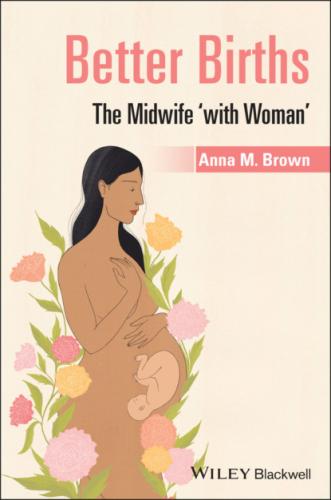References
1 Allison, J. (2016). Midwives of sixteenth‐century rural East Anglia. Rural History 27 (1): 1–19.
2 Amir, Z. and Reid, A.J. (2018). The cost of being “with women”: the impact of traumatic perinatal events on burnout rates amongst midwives. MIDIRS Midwifery Digest 28 (3): 307–308.
3 Andrews, N. (2017). Holding space: with women in a labyrinth. Midwifery 121: 9–11.
4 Astrup, J. (2016). In safe hands. Midwives 20 (2): 46–51.
5 Aune, I., Amundsen, H., and Akaget Aas, L. (2014). Is a midwife's continuous presence during childbirth a matter of course? Midwives' experiences and thoughts about factors that may influence their continuous support of women during labour. Midwifery 30: 89–95.
6 BenZion, M. (2018). Learning to trust birth though continuity of care. Midwifery 125: 18–22.
7 Bradfield, Z., Duggan, R., Hauck, Y. et al. (2018a). Midwives being “with woman”: an integrative review. Women and Birth 31: 143–152.
8 Bradfield, Z., Kelly, M., Hauck, Y., and Duggan, R. (2018b). Midwives “with woman” in the private obstetric model: where divergent philosophies meet. Women and Birth https://doi.org/10.1016/j.wombi.2018.07.013.
9 Bradfield, Z., Hauck, Y., Kelly, M., and Duggan, R. (2019a). Midwives' experiences of being “with woman” in a model where midwives are unknown. Midwifery 69: 150–157.
10 Bradfield, Z., Hauck, Y., Duggan, R. et al. (2019b). Midwives' perception of being “with woman”: a phenomenological study. BMC Pregnancy and Childbirth 19: 363. https://doi.org/10.1186/s12884‐019‐2548‐4.
11 Bradfield, Z., Hauck, Y., Kelly, M. et al. (2019c). “It's what midwifery is about”: Western Australian midwives' experiences of being “with woman” during labour and birth in the known midwife model. BMC Pregnancy and Childbirth 19: 29. https://doi.org/10.1186/s12884‐018‐2144‐z4.
12 Brady, S., Lee, N., Gibbons, K., and Bogossian, F. (2019). Women‐centred care: an integrative review of the empirical literature. International Journal of Nursing Studies 94: 107–119.
13 Burgess, A. (2014). An evolutionary concept analysis. International Journal of Childbirth Education 29 (2): 64–72.
14 Dahlberg, U. and Aune, I. (2013). The woman's birth experience‐ the effects of interpersonal relationship of continuity of care. Midwifery 29 (4): 407–415.
15 Davis, D.L. and Homer, C.S. (2016). Birthplace as the midwife's work place: how does place of birth impact on midwives? Women & Birth 29: 407–415.
16 Dolin, J. (2017). Thinking about the influences of informed choice. Midwifery 124: 50–51.
17 Evenden, E. (2000). The Midwives of Seventeenth‐Century London. Cambridge: Cambridge University Press.
18 Foster, J. (2017). Using research to advance nursing practice: A guide to concept analysis. Clinical Nurse Specialist 31 (2): 70–73.
19 Harley, D. (1990). Historians as demonologists: the myth of the midwife‐ witch. Social History of Medicine 3 (1): 1–26.
20 Harley, D. (1993). Provincial midwives in England: Lancashire and Cheshire, 1660 – 1760. In: The Art of Midwifery: Early Modern Midwives in Europe (ed. H. Marland), 27–48. London/New York: Routledge.
21 Higgins, T., Larson, E., and Schnall, R. (2017). Unravelling the meaning of patient engagement: a concept analysis. Patient Education and Counselling 100: 30–36.
22 Huber, U.S. and Sandall, J. (2009). A qualitative exploration of the creation of calm in a continuity of carer model of maternity care in London. Midwifery 25: 613–621.
23 Hunter, L.P. (2002). Being with woman: a guiding concept for the care of labouring women. Journal of Obstetric, Gynecologic, & Neonatal Nursing 31: 650–657.
24 Hunter, P. (2009). A descriptive study of “Being with Woman” during labour and birth. Journal of Midwifery & Women's Health 54 (2): 111–118.
25 Hunter, L. (2015). Being with woman: claiming midwifery space. Practising Midwife 18 (3): 20–22.
26 Hunter, L., Snow, S., and Warriner, S. (2017). Being there and reconnecting: Midwives' perceptions of the impact of mindfulness training on their practice. Journal of Clinical Nursing 27: 1227–1238.
27 Knapp, R. (2017a). Wellbeing and resilience 1. The resilient midwife. Practising Midwife 20 (3): 26–28.
28 Knapp, R. (2017b). The resilient midwife 2: The self‐compassionate midwife. Practising Midwife 20 (5): ePub.
29 Leap, N. (2009). Woman‐centred or women‐centred care: does it matter? Midwifery 17 (1): 12–16.
30 Leap, N. and Hunter, B. (1993). The Midwife's Tale: An Oral History from Handy Woman to Professional Midwife. London: Scarlet Press.
31 Leinweber, J. and Rowe, H.J. (2010). The cost of “being with woman”: secondary traumatic stress in midwifery. Midwifery 26: 76–87.
32 Llewelyn Davies, M. (ed.) (1915, reprinted 1978). Maternity: Letters from Working Women Collected by the Women's co‐Operative Guild. London: Virago.
33 Marland, H. (ed.) (1993). The Art of Midwifery: Early Modern Midwives in Europe. London/New York: Routledge.
34 McDonald, S. (2011). Women who receive continuous support during labour have reduced risk of caesarean, instrumental delivery or need for analgesia compared to usual care: systematic review. Midwifery 16 (2): 40–41.
35 McIntosh, T. (2012). A Social History of Maternity and Childbirth: Key Themes in Maternity Care. London/New York: Routledge.
36 Menage, D., Bailey, E., Lees, S., and Coad, J. (2017). A concept analysis of compassionate midwifery. Journal of Advanced Nursing 73 (3): 558–573.
37 Myles, M. (1953). A Textbook for Midwives. Edinburgh: E & S Livingstone Ltd.
38 Nursing & Midwifery Council (2019). Standards of proficiency for midwives. www.nmc.org.uk/globalassets/sitedocuments/standards/standards‐of‐proficiency‐for‐midwives.pdf (accessed 10 January 2020).
39 Nystedt, A., Kristiansen, L., Ehrenstrale, K. et al. (2014). Exploring some Swedish women's experiences of support during childbirth. International Journal of Childbirth 4 (3): 183. https://doi.org/10.1891/2156‐5287.4.3.183.
40 Perriman, N., Davis, D.L., and Ferguson, S. (2018). What women value in the midwifery continuity of care model: a systematic review with meta‐synthesis. Midwifery 62: 220–229.
41 Power, A., Davidson, S., and Patrick, K. (2016). Being “with woman” in contemporary midwifery practice: one Trust's response to the Francis report. British Journal of Midwifery 24 (10): 711–713.
42 Reed, R., Rowe, J., and Barnes, M. (2016). Midwifery practice during birth: ritual companionship. Women and Birth 29: 269–278.
43
